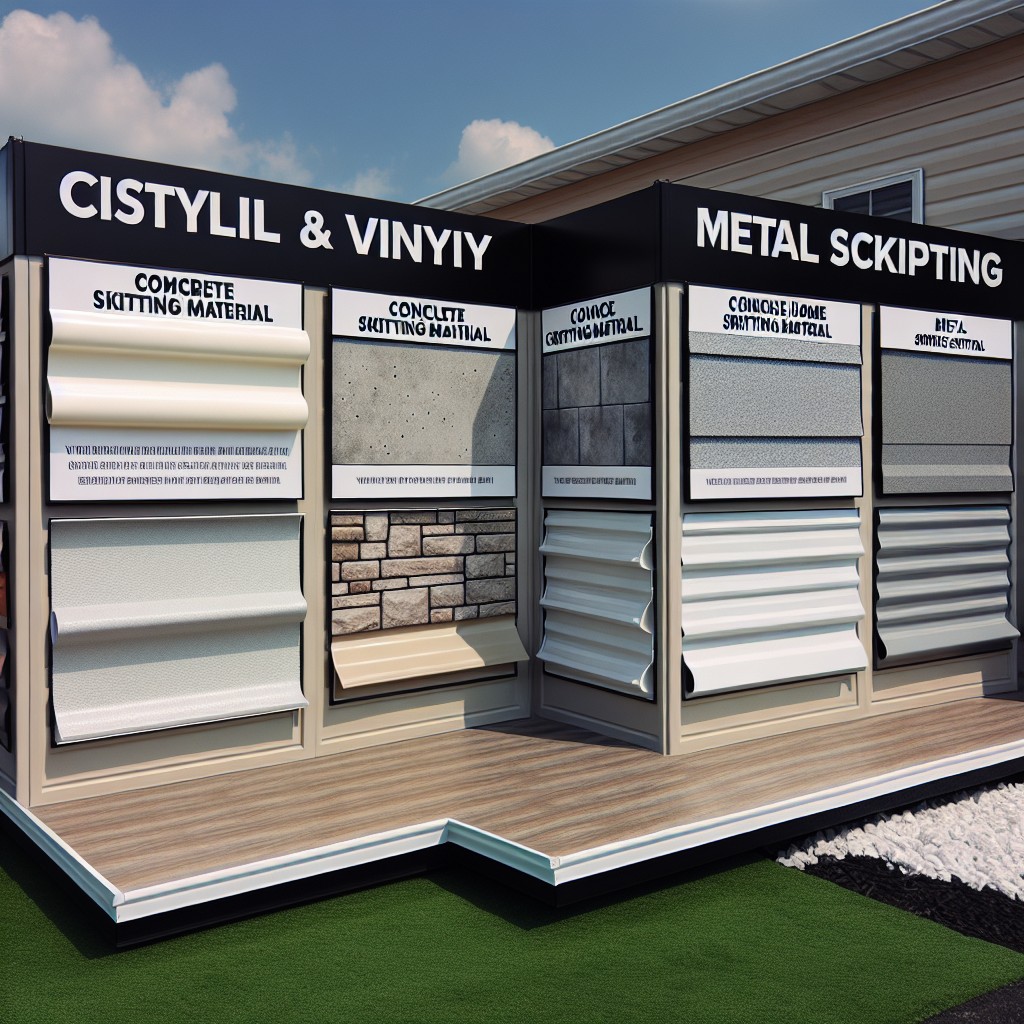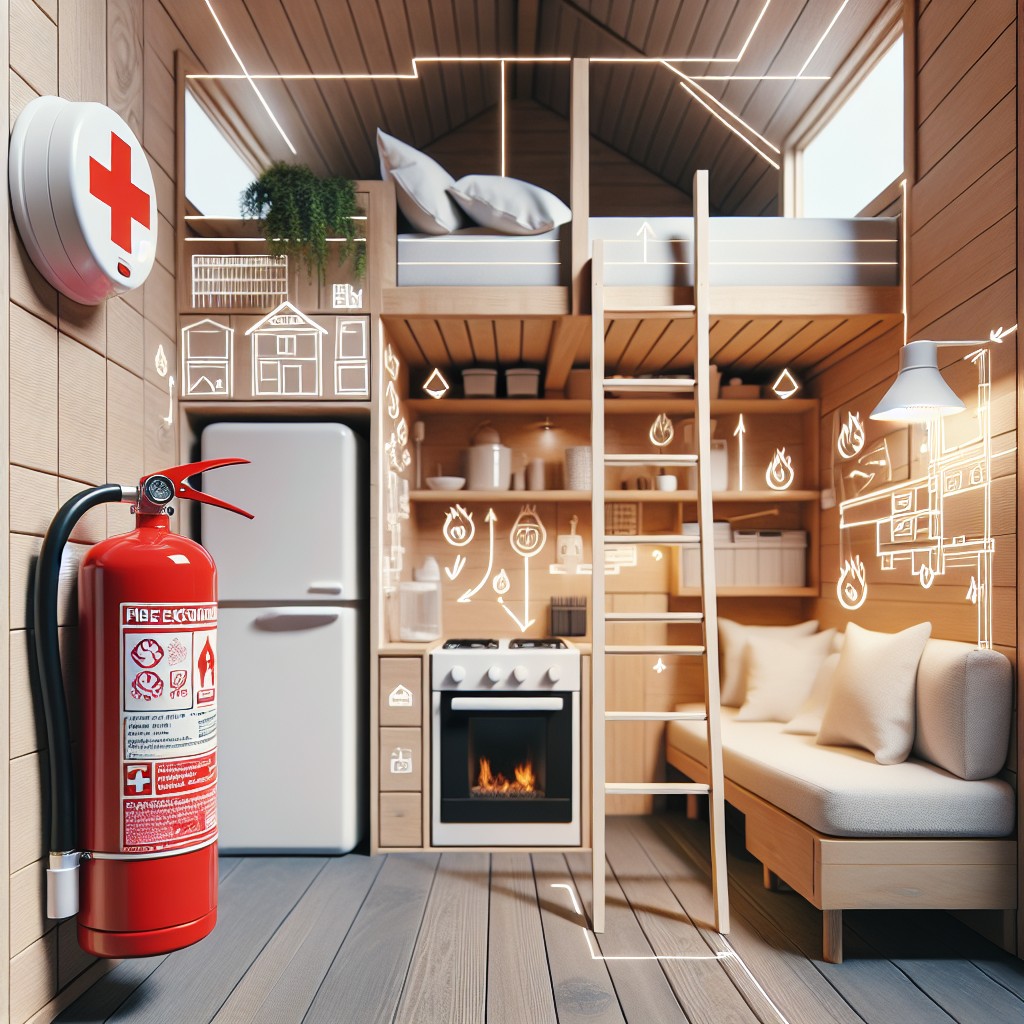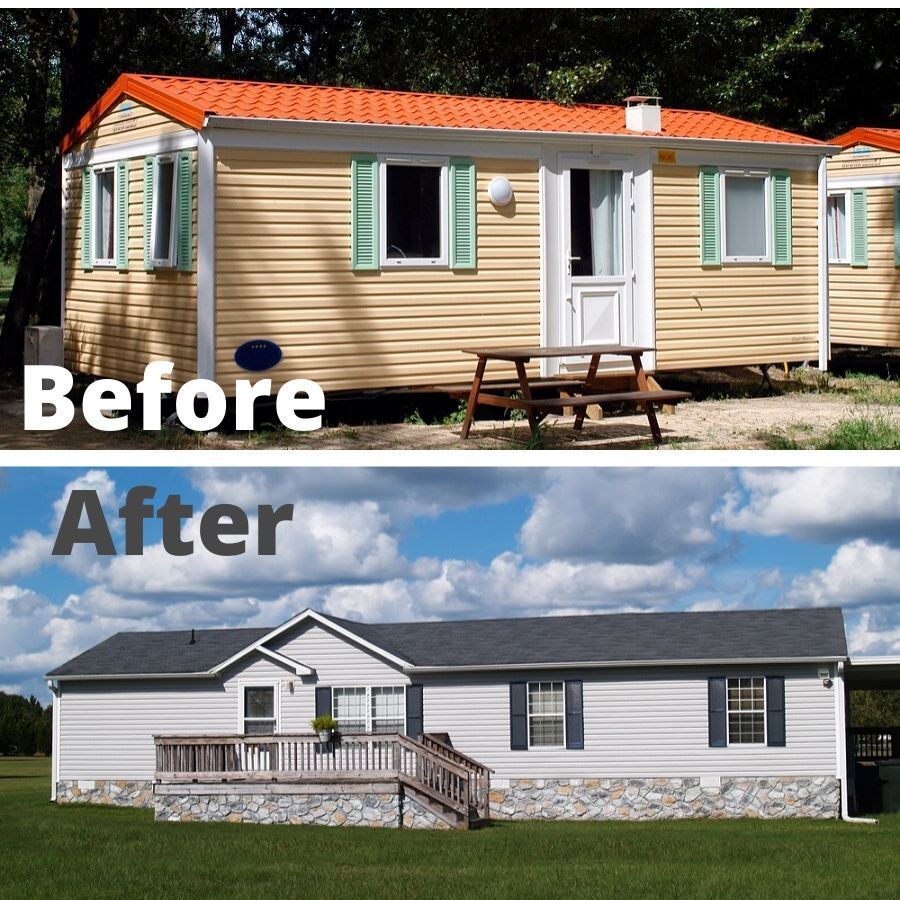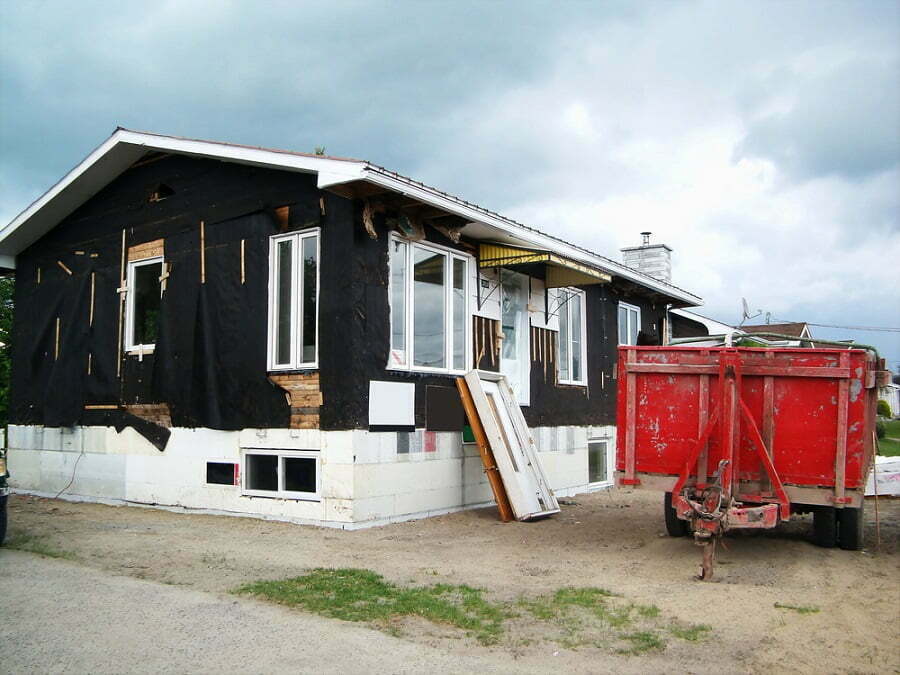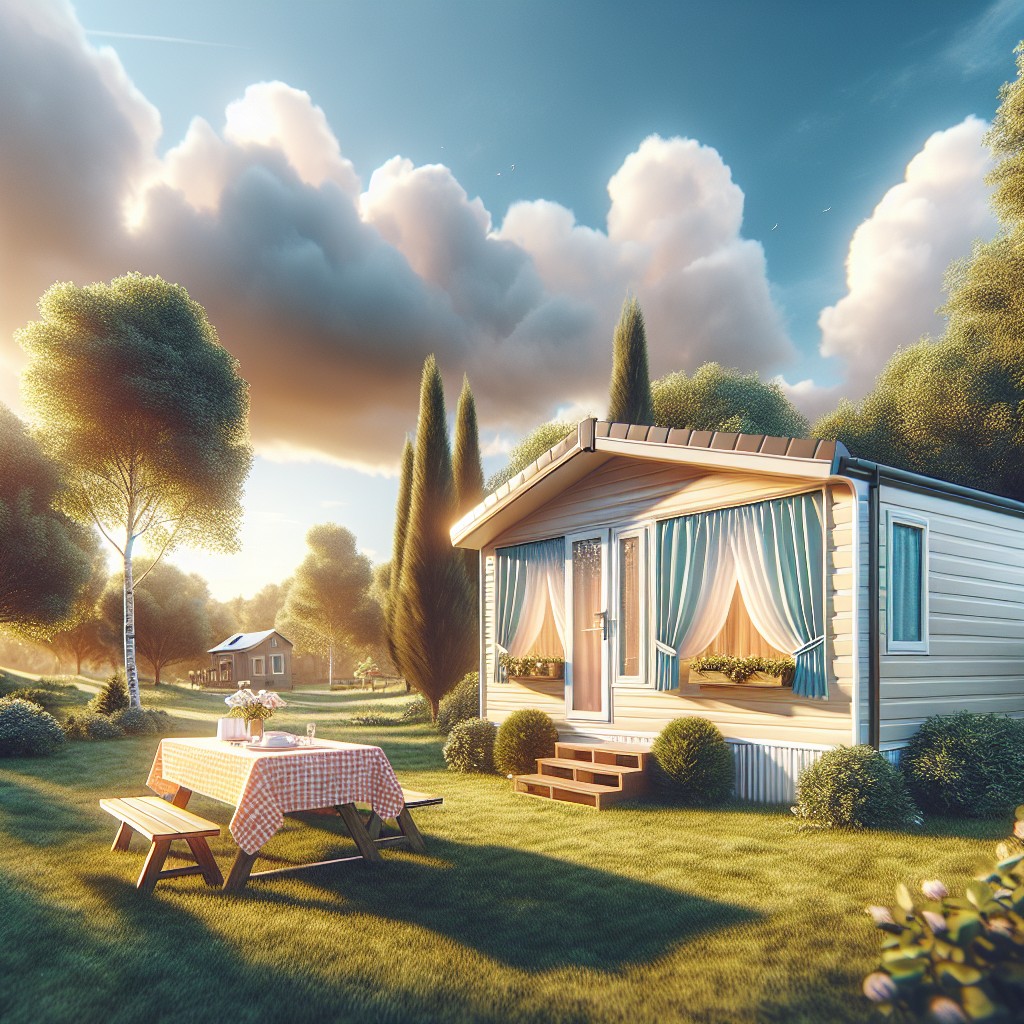Last updated on
Keeping your old mobile home cool in hot weather is possible, simply by adopting green techniques, because these sustainability-focused methods not only prevent discomfort from heat but also have a rollback effect on your energy bills.
Keeping an old mobile home cool during intensely hot weather can be quite a challenge, but there are several effective strategies you can leverage. One perfect starting point is ventilation – ensuring windows, doors, and vents provide optimal air circulation. Installing window screens and shades can prevent the sun’s direct heat, while a roof coating can act as a radiant barrier. Use of energy-efficient appliances can also help to reduce heat inside. Insulating the home properly will keep hot air out and cool air in, thereby enhancing comfort. These are just a few highlights, the detailed guide ahead will explore other numerous tips and tricks to ensure your old mobile home remains cool, even in the hottest weather conditions.
Key takeaways:
- Maximize window efficiency with reflective film and shades
- Apply reflective or insulating window film to block solar heat
- Install heat-reflective blinds or shades for solar gain reduction
- Enhance roof efficiency with cool roof coatings and extended eaves
- Improve air circulation with strategic fan placement and ceiling fans
Optimize Window Usage

Maximizing the efficiency of your windows can significantly affect the temperature of your mobile home. Reflective window film helps by bouncing back the sun’s rays, preventing heat from entering.
Likewise, installing heat-reflective blinds or shades provides a barrier against solar gain, keeping your living space comfortably cooler.
Remember, proper installation is key to ensuring these measures work effectively, enabling you to enjoy a fresher indoor climate while potentially reducing the need for air conditioning.
Apply Reflective or Insulating Window Film
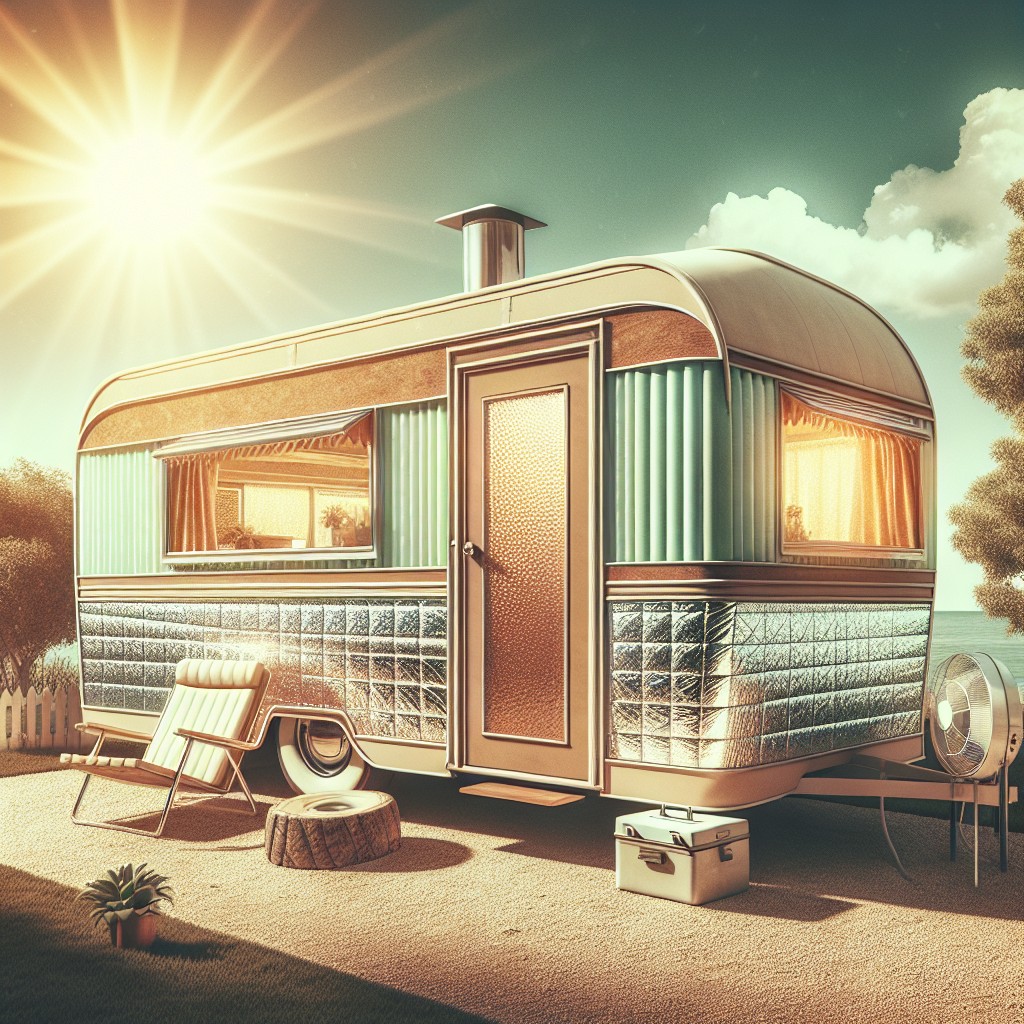
Installing window film is an effective method to block out solar heat. By reflecting sunlight away from your home, these thin layers can significantly reduce the amount of heat that enters your abode. Not only do they assist in maintaining a cooler interior without overworking the air conditioning system, but they also provide an additional layer of privacy.
When selecting a window film, consider the following points:
- Look for films with high solar reflectance ratings to maximize heat rejection.
- Ensure the chosen film is compatible with your window type to avoid glass damage.
- Professional installation can ensure a smooth, bubble-free application, although DIY options are available.
- Insulating films can help retain heat during colder months, offering year-round benefits.
- Regular cleaning with a non-abrasive solution will maintain film effectiveness over time.
By keeping these factors in mind, you can enhance your mobile home’s ability to stay cool while also being energy efficient.
Install Heat Reflective Blinds or Shades
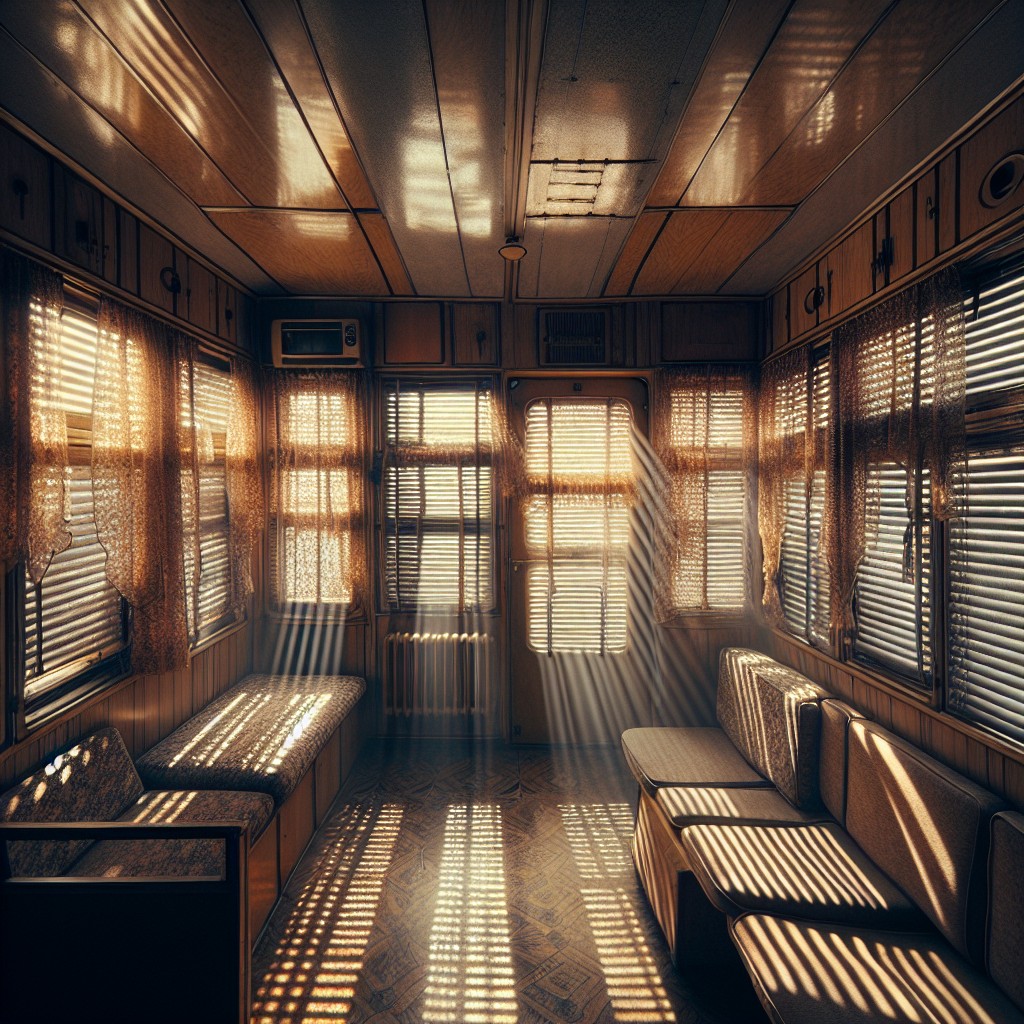
Maximizing the use of blinds or shades can significantly reduce the solar heat gain in your mobile home. Opt for materials with reflective properties that bounce back sunlight to keep living spaces cooler. Light-colored fabrics or slats disperse sunlight effectively, while darker tones may absorb heat—increasing indoor temperature.
Consider cellular shades, which trap air in their honeycomb-shaped cells, forming an insulation barrier against heat transfer. When closed during the brunt of the daylight hours, these shades can curtail the indoor heat surge.
Roller shades with a reflective backing also make for a smart choice. When pulled down, they act as a shield against solar penetration. Ensure shades fit closely to windows to eliminate heat seeping through gaps.
Periodically dusting and cleaning your blinds or shades not only maintains their appearance but also ensures they reflect light efficiently, contributing to a cooler home environment even during the sweltering summer months.
Enhance Roof Efficiency
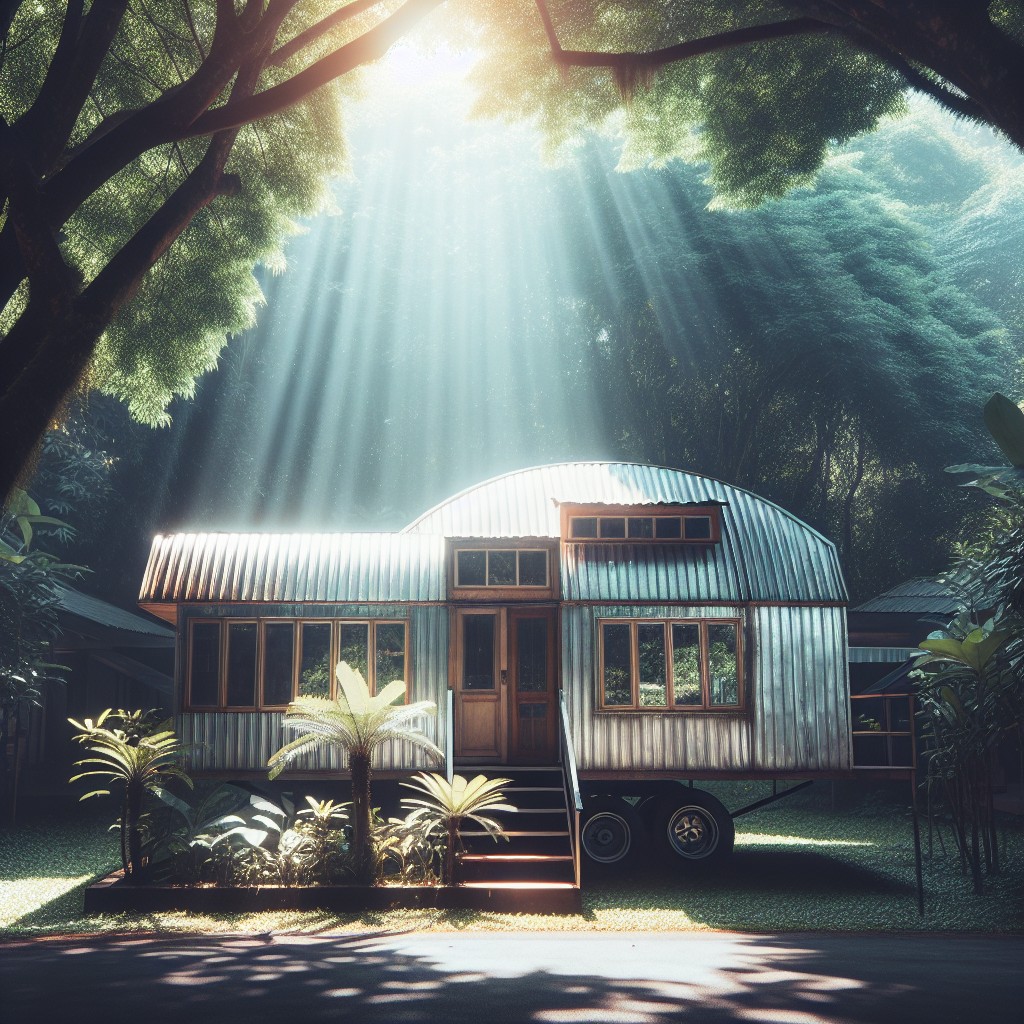
A cool roof reflects more sunlight and absorbs less heat than a standard roof, significantly reducing your home’s internal temperature. Here’s how you can enhance your mobile home’s roof efficiency:
- Apply a cool roof coating designed for mobile homes – look for aluminized asphalt or elastomeric products that create a reflective layer.
- Select light-colored or white coatings to maximize sunlight reflection.
- Consider extending eaves or adding an over-roof, which is an additional roof layer that creates an air gap, reducing heat transfer.
Making these changes can lead to a cooler home, lower air conditioning costs, and a more comfortable living environment during the hot summer months.
Apply Cool Roof Coatings Such As Aluminized Asphalt or Elastomeric Coatings
Transforming your mobile home’s roof into a reflective surface combats solar heat gain. A coating of aluminized asphalt deflects sunlight, significantly diminishing heat absorption. Elastomeric coatings offer a similar benefit, with the added advantage of expanding and contracting with the roof material, reducing the risk of cracks and damage.
When applying these coatings:
- Ensure your roof is clean, dry, and clear of debris to guarantee good adhesion.
- Follow the manufacturer’s instructions; some coatings need a primer, while others are ready-to-apply.
- Consider application methods; rollers, brushes, and sprays are commonly used, each with its specific technique.
Remember, a cool roof coating can lower indoor temperatures, potentially reducing air conditioning needs and prolonging the life of your cooling systems. Regular inspections will keep your cool roof functioning efficiently.
Improve Air Circulation
Maximizing the breeze within your mobile home is essential for cooling. Strategically place portable fans near windows or doors to create a cross-ventilation system that moves hot air out and allows cool air to circulate. This inexpensive method can significantly lower the temperature inside your home.
Ceiling fans are another effective tool, which when set to run counterclockwise, push cool air down and help evaporate perspiration on the skin, amplifying the cooling effect for residents. Remember to turn off fans in unoccupied rooms to conserve energy, as the cooling benefits are solely for people, not the room itself. Regularly cleaning fan blades will also ensure optimal performance and improved air movement.
Use Portable Fans Strategically Throughout the Home
Maximize airflow by placing fans in areas where people spend the most time, such as living rooms or bedrooms, ensuring they face towards the center of the room for optimal air distribution. Position fans near windows to pull cooler outside air into the home during evening hours or expel hot air during the day.
Create a cross breeze by setting up fans across from each other in a room. Elevate fans on stable surfaces to circulate air at a higher level for more even cooling. Rotate ceiling fans counterclockwise to push cooler air down and help evaporate sweat on the skin, increasing the body’s natural cooling process.
Remember to turn off fans in unoccupied rooms to conserve energy.
Consider Installing Ceiling Fans
Ceiling fans create a wind-chill effect, making occupants feel cooler without necessarily lowering the room temperature. They consume less energy than air conditioning units, thereby reducing electricity bills.
When installing, ensure the fan is at least 7 to 9 feet above the floor and 10 to 12 inches below the ceiling for optimal performance. Fans should rotate counter-clockwise during summer to push cool air down. In rooms with high ceilings, a downrod can position the fan at an ideal height for maximum cooling.
Remember to switch off fans in unoccupied rooms, as their cooling effect is best felt directly.
Upgrade Insulation
Enhancing your mobile home’s thermal barrier is key to maintaining a cool interior. Adding insulation to walls and floors traps cool air inside and serves as a blockade against heat intrusion.
For walls, look into blown-in or foam insulation options that can be injected without the need for extensive renovations. In flooring, reflective insulation is advantageous, reflecting heat away while keeping interior temperatures lower.
Weather-stripping around doors and windows is a cost-effective measure that seals gaps and prevents cool air from seeping out. Choose materials like foam, rubber, or silicone for a durable seal.
Ensuring these areas are airtight improves energy efficiency and helps your cooling systems work less to achieve comfort, thus extending their life span.
Regularly check the integrity of these seals, especially before the onset of warm seasons, to assure your home stays cool and your energy bills lower.
Insulate Walls and Floors to Retain Cool Air
Maximizing your mobile home’s cool air retention hinges largely on proper insulation. In walls, adding fiberglass, foam, or reflective insulation can dramatically decrease thermal exchange.
For floors, consider thick foam boards or batt insulation beneath your home to prevent ground heat from seeping in. Insulated skirting plays a dual role: it aids in temperature control and deters unwanted pests.
Remember that newer, eco-friendly options like recycled denim or sheep’s wool provide effective, sustainable alternatives. Sealing any gaps with caulk or expanding foam ensures airtightness, further helping to keep your living space comfortably cool.
Weather-strip Doors and Windows to Prevent Air Leaks
Sealing gaps around doors and windows is a cost-effective way to enhance your mobile home’s cooling efficiency. A well-sealed home prevents the intrusion of warm air and the loss of cooled air, stabilizing indoor temperatures. Here’s how to effectively use weather stripping:
1. Choose the Right Materials: Foam, felt, vinyl, or metal strips are available for different types of doors and windows. Foam is inexpensive and easy to install, while metal strips last longer and provide a tight seal.
2. Inspect Existing Seals: Check all doors and windows for old or damaged weather stripping. Look for areas where daylight is visible or where you can feel drafts.
3. Clean Surfaces: Before applying new weather stripping, clean the surfaces thoroughly to ensure good adhesion and a long-lasting seal.
4. Measure and Cut: Measure the space around each door and window, and cut your weather stripping to fit. Precision here helps avoid gaps and overlaps that can compromise the seal.
5. Install Properly: Follow the manufacturer’s instructions for installation. Typically, you’ll peel and stick, nail, or tack the weather stripping into place, ensuring a snug fit without hampering the operation of doors and windows.
6. Verify Effectiveness: Once installed, test the seal by closing doors and windows on a piece of paper. If the paper doesn’t slide out easily, you’ve created a good seal.
By attending to these details, you can significantly reduce the unnecessary workload on your cooling system, keeping your mobile home comfortable even during the warmest months.
Utilize Natural Ventilation
Harnessing the cooler air during early morning and evening hours can significantly lower indoor temperatures. Cross-ventilation is key; open windows on opposite sides of your mobile home to create a refreshing through-breeze.
For upper-level windows, consider using locking window guards that allow safe ventilation while maintaining security. In the absence of natural breezes, placing a fan near a window can draw cooler outside air into your living spaces.
To further leverage airflow, open cabinet doors and closets to avoid heat traps, ensuring every corner benefits from the cooler air. Remember, proper ventilation also helps in reducing humidity levels, further enhancing the comfort of your home.
Open Windows During Cooler Times of the Day
Harnessing the natural drop in temperature during early morning and late evening hours can help maintain a cooler environment inside your mobile home without the need for energy-consuming appliances. By opening windows on opposite sides of the home, you can create a cross-breeze that facilitates airflow, effectively drawing cooler air in and pushing warm air out.
It’s essential to close the windows again as temperatures rise to trap the cooler air inside for as long as possible. Also, keeping curtains closed during the day can prevent the sun from heating indoor spaces, allowing the cool air from the night to sustain a comfortable temperature for a longer period.
Air Conditioning Considerations
Selecting the right size unit is crucial; an undersized air conditioner won’t cool your home effectively, while an oversized one can lead to increased humidity and energy waste. A professional can help determine the proper size based on your mobile home’s square footage.
Periodic maintenance can’t be overstated. Clean your air conditioning filters every month, especially during high usage, to ensure unobstructed airflow and peak performance. Also, have your unit serviced annually by a technician to prolong its lifespan and maintain efficiency.
Consider upgrading to a more energy-efficient model if your air conditioner is old. Modern units use substantially less energy to provide the same cooling, which could translate to lower electricity bills and a more comfortable living environment. Look for models with a higher Seasonal Energy Efficiency Ratio (SEER) for best results.
Finally, check your unit’s placement. Ensure the external part of a split system isn’t in direct sunlight, as this can reduce its effectiveness. A shaded spot or a protective cover can make a noticeable difference in performance.
Use a Properly Sized Window or Central Air Conditioning Unit
Selecting the appropriate air conditioning unit for your mobile home is pivotal to maintain a comfortable environment. An oversized AC unit cycles on and off too quickly without properly dehumidifying the air, while an undersized unit will be inefficient, running continuously and driving up your energy bill.
Here’s what to keep in mind:
- Determine the square footage of space requiring cooling to assess the capacity needed, measured in British Thermal Units (BTUs).
- Consult with HVAC professionals who can perform load calculations, considering factors such as home layout and local climate.
- Remember, for mobile homes, specifically, you may need a unit designed to work with the unique ductwork and ventilation systems commonly found in these structures.
- Ensure the AC unit’s location facilitates optimal airflow and doesn’t obstruct living spaces.
- Placement is key; for window units, choose a window that is shaded during the hottest part of the day to enhance efficiency.
Smart selection combined with strategic placement will ensure that your cooling system works effectively without placing undue strain on your energy consumption or comfort during those sweltering days.
Maintain and Clean AC Filters Regularly for Efficiency
Maintaining your mobile home’s AC unit is crucial for keeping cool air flowing efficiently. A clogged or dirty filter not only restricts airflow, leading to a harder-working AC system and increased energy costs, but it can also diminish indoor air quality. To ensure peak performance, here’s what you can do:
- Regular Cleaning: At minimum, rinse or vacuum reusable filters monthly during peak usage seasons. If you have disposable filters, replace them according to the manufacturer’s guidelines, typically every 1-3 months.
- Check Filter Fit: Ensure no gaps around the filter frame when you reinstall it, as poor fitting filters allow dirt to bypass the filter altogether.
- Seek Expert Advice: When in doubt, consult with an HVAC professional to identify the correct filter type for your specific unit and the recommended maintenance schedule.
- Monitor Air Flow: After cleaning or replacing the filter, notice if there is an improvement in air flow and cooling. This can be a simple hand test near the vent.
Adhering to these steps can significantly contribute to a cooler and more comfortable space, all while keeping your AC unit in top condition.
Reduce Internal Heat Sources
Minimizing the amount of heat generated inside your mobile home can significantly contribute to a cooler living environment. Opt for cooking during the early morning or late evening to avoid the peak heat of the day, and when possible, cook outside on a grill to keep heat out of the kitchen.
Swap out incandescent bulbs, which emit more heat, for energy-efficient LED lights that stay cooler. Keep electronics and appliances turned off when not in use, as these can also generate unwanted warmth. Running a dishwasher or dryer at night can prevent heat build-up during daytime hours.
By being mindful of the heat sources within your home and adjusting their use accordingly, you can maintain a cooler and more comfortable space.
Limit Appliance Usage During Peak Heat Hours
Operate heat-generating devices such as ovens, stovetops, and clothes dryers during cooler times, typically early morning or late evening. This practice reduces the strain on your cooling system during the warmest hours, thereby maintaining a cooler environment and conserving energy.
Similarly, limit the use of dishwashers or switch to air-dry settings, and consider grilling outdoors or preparing cold meals to further minimize indoor heat buildup. By managing when and how you use these appliances, you effectively contribute to a cooler and more comfortable living space without overworking your cooling systems.
Landscaping for Shade
Strategic planting can significantly lower indoor temperatures. By positioning trees on the east and west sides, you’ll block harsh morning and afternoon sun, making the biggest impact on cooling. Choose deciduous varieties for areas you want summer shade and winter sun; they lose leaves in cold months, letting sunlight pass.
Shrubs and bushes can shield lower portions of your home and can be placed near windows to serve as natural air conditioners. Green foliage absorbs sunlight and can also cool breezes before they enter your home through windows or vents.
For immediate results while trees mature, consider installing a trellis with fast-growing vines directly outside windows. This green screen can filter sunlight before entering the home.
Also, installing awnings or overhangs can extend shade beyond the immediate footprint of the foliage, especially for windows not easily shaded by trees. A well-designed landscape not only cools your home but also creates a refreshing outdoor environment.
Plant Trees or Shrubs to Provide External Shading
When selecting trees, opt for deciduous varieties, as they lose their leaves in winter, allowing sunshine to warm your home during colder months. Place them strategically to block direct sunlight from entering windows, which is particularly effective on the east and west sides where the sun is most intense.
Similarly, shrubby perennials can shield lower windows and walls from the heat. Remember that growth takes time, so while this is a long-term strategy, it’s also an investment in your property’s aesthetics and ecosystem.
Consider fast-growing species if immediate relief is a priority, but make sure they are suitable for your local climate and soil conditions.
FAQ
What is the cheapest way to cool a mobile home?
The most affordable method to cool a mobile home is by installing shades, drapes, or other window coverings, which block sunlight and help to keep the interior cool during summer.
Why is my mobile home so hot in the summer?
Your mobile home can become unbearably hot during the summer due to thermal transfer, which occurs when outside heat infiltrates your home either directly through air leaks around doors, windows, or plumbing, or indirectly via solid surfaces like floors, ceilings, walls, and doors.
What is the best way to heat an older mobile home?
The best way to heat an older mobile home is by utilizing a heat pump, renowned for its dual function of heating and cooling and remarkable energy efficiency.
How can insulation enhancement improve cooling efficiency in an antique mobile home?
Insulation enhancement can improve cooling efficiency in an antique mobile home by reducing the amount of cool air that escapes, thus lessening the burden on air conditioning systems and leading to significant energy savings.
Can installing energy-efficient windows control the temperature in a vintage mobile home?
Yes, installing energy-efficient windows can contribute significantly to controlling the temperature in a vintage mobile home by reducing heat loss in winter and heat gain in summer.
What type of cooling systems are suitable for an older mobile home?
Window air conditioners and ductless mini-split systems are suitable cooling systems for an older mobile home.
Related reading:
Table of Contents
